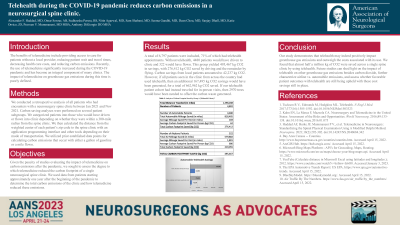Telehealth during the COVID-19 pandemic reduces carbon emissions in a neurosurgical spine clinic.
Telehealth During the COVID-19 Pandemic Reduces Carbon Emissions in a Neurosurgical Spine Clinic
Friday, April 21, 2023


Omar Sorour, AB (he/him/his)
Medical Student
UMass Chan Medical School
Westwood, Massachusetts, United States
ePoster Presenter(s)
Introduction: The use of telemedicine significantly increased during the COVID-19 pandemic and has become an integral component of many clinics. The impact of telemedicine on greenhouse gas emissions is poorly defined. The aim of this study was to evaluate the impact of telehealth on carbon emissions for patients of a neurosurgery spine clinic.
Methods: A retrospective analysis of all patients who had encounters with a neurosurgery spine clinic between January 2021 and November 2021 was performed. Patients utilizing telehealth technologies were identified. Carbon saving analyses were performed on various patient subgroups.
Results: A total of 6,797 patients were included with 71% having telehealth appointments. Without telehealth, we assumed that 4,480 patients would have driven to clinic and 322 would have flown. This group yielded an overall 495,467 kg CO2 in savings, with 276,412 kg CO2 saved by not driving and the remainder by not flying. Carbon savings from local patients alone was 42,237 kg CO2. In addition, if all patients seen in the clinic from across the United States used telehealth, this would have generated an additional 167,495 kg CO2 savings for a total of 662,962 kg CO2 savings. If our telehealth patient cohort had instead traveled for in-person visits, then 2,970 trees would have been needed to offset the carbon waste generated.
Conclusion : Telehealth technologies are effective tools in reducing overall carbon emissions from a neurosurgical spine clinic. Additional investigation into the use of telehealth in neurosurgical clinics is warranted.
Methods: A retrospective analysis of all patients who had encounters with a neurosurgery spine clinic between January 2021 and November 2021 was performed. Patients utilizing telehealth technologies were identified. Carbon saving analyses were performed on various patient subgroups.
Results: A total of 6,797 patients were included with 71% having telehealth appointments. Without telehealth, we assumed that 4,480 patients would have driven to clinic and 322 would have flown. This group yielded an overall 495,467 kg CO2 in savings, with 276,412 kg CO2 saved by not driving and the remainder by not flying. Carbon savings from local patients alone was 42,237 kg CO2. In addition, if all patients seen in the clinic from across the United States used telehealth, this would have generated an additional 167,495 kg CO2 savings for a total of 662,962 kg CO2 savings. If our telehealth patient cohort had instead traveled for in-person visits, then 2,970 trees would have been needed to offset the carbon waste generated.
Conclusion : Telehealth technologies are effective tools in reducing overall carbon emissions from a neurosurgical spine clinic. Additional investigation into the use of telehealth in neurosurgical clinics is warranted.
